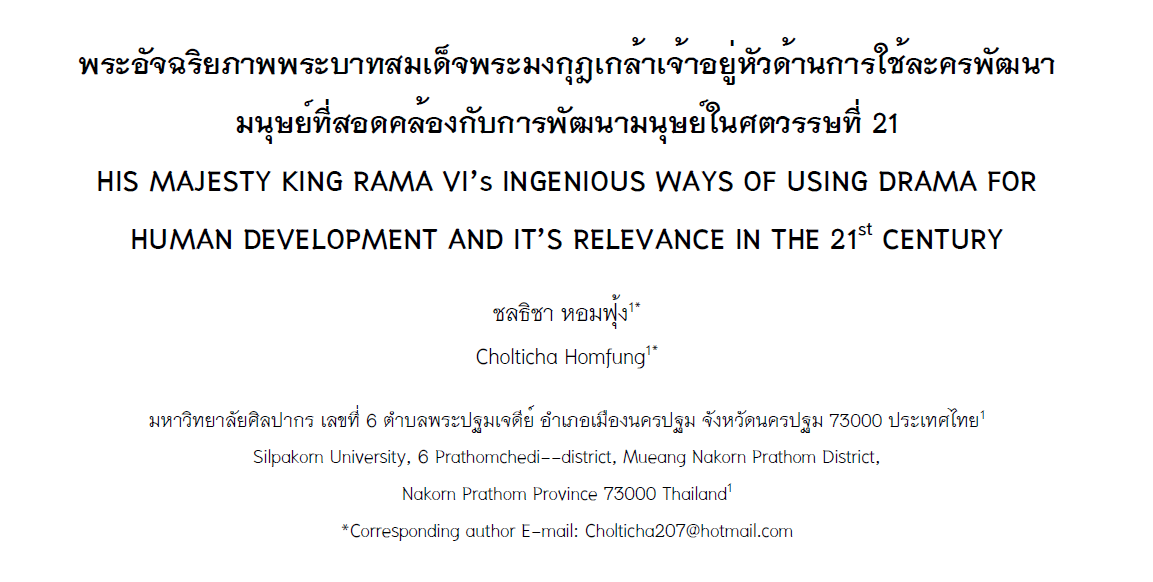พระอัจฉริยภาพพระบาทสมเด็จพระมงกุฎเกล้าเจ้าอยู่หัวด้านการใช้ละครพัฒนามนุษย์ที่สอดคล้องกับการพัฒนามนุษย์ในศตวรรษที่ 21
Main Article Content
บทคัดย่อ
บทความนี้มีจุดประสงค์เพื่อ 1) ศึกษาวิธีการแสดงละครพระราชนิพนธ์พระบาทสมเด็จพระมงกุฎเกล้าเจ้าอยู่หัวที่สอดคล้องกับการพัฒนามนุษย์ในศตวรรษที่ 21 และ 2) ศึกษาพระอัจฉริยภาพพระบาทสมเด็จพระมงกุฎเกล้าเจ้าอยู่หัวผ่านงานละครที่สอดคล้องกับการพัฒนามนุษย์ในศตวรรษที่ 21 วิธีการศึกษาคือการวิเคราะห์เอกสาร ผลการศึกษาพบว่า 1) บทละครพระราชนิพนธ์พระบาทสมเด็จพระมงกุฎเกล้าเจ้าอยู่หัวประเภทเค้าโครงเรื่องสำหรับการแสดง และละครปริศนาช่วยพัฒนามนุษย์ได้สอดคล้องกับการพัฒนามนุษย์ในศตวรรษที่ 21 ด้านทักษะการเรียนรู้และนวัตกรรมทั้ง 4 ด้าน ได้แก่ การคิดอย่างมีวิจารณญาณและการแก้ปัญหาสร้างสรรค์ ความคิดสร้างสรรค์ การสื่อสาร และการทำงานร่วมกัน 2) พระอัจฉริยภาพของพระบาทสมเด็จพระมงกุฎเกล้าเจ้าอยู่หัวที่สะท้อนผ่านงานละคร ได้แก่ ด้านความคิดสร้างสรรค์ ด้านพระราชวิสัยทัศน์ที่กว้างไกลในการพัฒนาทรัพยากรมนุษย์ และด้านการทรงเป็นนักการศึกษา แนวคิดในการพัฒนามนุษย์ของพระบาทสมเด็จพระมงกุฎเกล้าเจ้าอยู่หัวนับว่าเป็นสิ่งที่เป็นสากลที่ยังเป็นแนวคิดสำคัญในการพัฒนามนุษย์ในศตวรรษที่ 21 และยังต่อยอดนำมาประยุกต์ใช้ในการพัฒนาทรัพยากรมนุษย์ในปัจจุบันได้
Downloads
Article Details

อนุญาตภายใต้เงื่อนไข Creative Commons Attribution-NonCommercial-NoDerivatives 4.0 International License.
บทความที่ได้รับการตีพิมพ์เป็นลิขสิทธิ์ของบัณฑิตวิทยาลัย มหาวิทยาลัยราชภัฎเชียงใหม่
ข้อความที่ปรากฏในบทความแต่ละเรื่องในวารสารวิชาการเล่มนี้เป็นความคิดเห็นส่วนตัวของผู้เขียนแต่ละท่านไม่เกี่ยวข้องกับมหาวิทยาลัยราชภัฎเชียงใหม่ และคณาจารย์ท่านอื่นๆ ในมหาวิทยาลัยฯ แต่อย่างใด ความรับผิดชอบองค์ประกอบทั้งหมดของบทความแต่ละเรื่องเป็นของผู้เขียนแต่ละท่าน หากมีความผิดพลาดใด ๆ ผู้เขียนแต่ละท่านจะรับผิดชอบบทความของตนเองแต่ผู้เดียว
เอกสารอ้างอิง
Benge, G. (2017). Creative drama in the classroom: Expanding and enhancing creative thinking. (Master’s thesis, California State University).
Chutintaranond, T. (2018). Portrayal of new women images in Thai society through female protagonists in King Rama VI’s play scripts. Academic Journal of Humanities and Social Sciences, 26(52), 49-69. [In Thai]
Galante, A., and Thomson, R. I. (2017). The effectiveness of drama as an instructional approach for the development of second language oral fluency, comprehensibility, and accentedness. TESOL Quarterly, 51(1), 115-142.
Homfung, C. (2014). The development of an instructional model by applying the four noble truths to enhance critical reading and creative problem solving abilities of undergraduate students. (Doctoral’s thesis, Silpakorn University). [In Thai]
Malakul, P. M. L. (1974). Collection of lectures by M.L. Pin Malakul. Bangkok: Kurusapa Business Organization. [In Thai]
Malakul, P. M. L. (1975). Drama work of His Majesty King Ramathibodi Srisin Maha Vajiravudh, King of Siam. Bangkok: Thai Watana Panich Publishing Co., Ltd. [In Thai]
Malakul, P. M. L. (1990). What did King Mongkut do regarding literature? In Lecture and exhibition project committee His Majesty King Mongkut Klao. Silpakorn Unoversity. (editor). Somdej Phra Maha Theerarat, the philosopher of Siam. (pp. 3-5). Nakorn Pathom: Silpakorn Unoversity. [In Thai]
Mina, P. (2016). King Rama VI’s Creativities of Setting on Comedies Adaptionsof French Comedies. T.L.A. Bulletin, 60(1), 11-20. [In Thai]
Nukulkit, S. (2000). Contemporary Thai literature. Bangkok: S.R. Printing. [In Thai]
Partnership for 21st Century Learning (P21). (2019). Framework for 21st century learning definitions. Retrieved from https://www.battelleforkids.org/learning-hub/learning-hub-item/framework-for-21st-century-learning-definitions
Sujjapun, R. (2017). Dumb Crambo (A riddle drama): The genius of King Vajiravudh. Journal of Social Sciences and Humanities Research in Asia, 23(2), 3-24. [In Thai]
Vechasat, K. (1990). History of the drama work of His Majesty King Rama VI. On the lecture and exhibition project committee His Majesty King Mongkut Klao. Silpakorn Unoversity. (editor). Somdej Phra Maha Theerarat, the philosopher of Siam (pp. 8-35). Nakorn Pathom: Silpakorn Unoversity. [In Thai]
Yaemsunthorn, R. (2021). Creative drama for developing soft skills. The Journal of Research and Academics, 4(4), 305-317.


